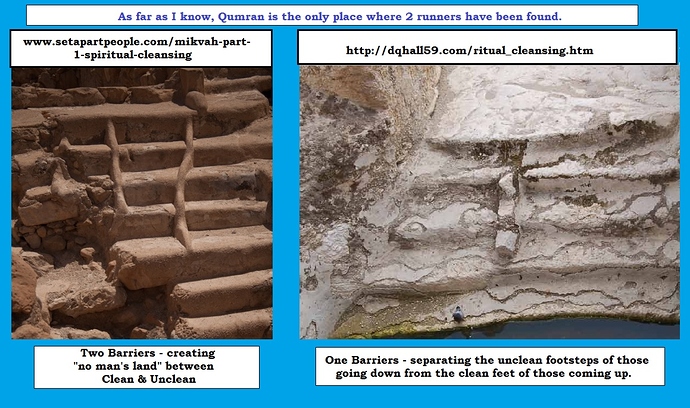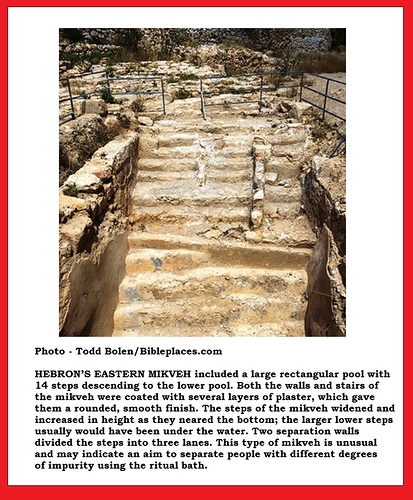Well, wouldn’t you know it … just this past October issue of the Biblical Archaeological Review, mentions that the distinct Qumran 2-divider stairways have been found in one other place:
in **two mikva'ot** of Hebron!
If we were going to make a prediction, it would be that Hebron was either the home of its own colony of Essenes, or of some other religious installation or community where purity was of special importance! I look forward to hearing more about it.
At the very least, it tells us that if the dividers in Qumran had something to do with special industrial production, it could be that the manufacture was for particularly sacred items, produced by men who had special qualifications for purity! Save this thought for the final paragraph below!
Special note on editing - I will eventually correct the spellings in this postings in this thread. In a side comment by David Ben-Shlomo, the proper English spelling for plural mikveh is “mikva’ot”, are provided: "Without a mikveh (plural, mikva’ot), we hesitated to label the site Jewish." My syntax for either form was quite in error.
Biblical Archaeology Review 43:5, September/October 2017
Hebron Still Jewish in Second Temple Times
By David Ben-Shlomo
" We know of occurrences of a single partition wall, creating two lanes, in mikva’ot in Jerusalem and near Hebron. This has usually been interpreted as a way to separate the impure ones descending to be immersed and the pure ones ascending from the water."
“. . . [A] mikveh with three lanes is known only from one other place: Khirbet Qumran, the site on the northern shore of the Dead Sea often linked to the Jewish sect of the Essenes and the Dead Sea Scrolls. Yet this feature is attested in both of Hebron’s mikva’ot! . . . . [where there] . . . was the division of the wide stairs into three paths by two low plastered partition walls.”
“The reason for the double separation is not clear. Perhaps the aim was to separate visitors with varying degrees of impurity, or possibly it was related to Hebron’s status as a Levite and priests’ town. However, what may be more significant are the resemblances between the Second Temple period sites of Hebron and Qumran.”
[Special Clay Jars are for scrolls?!]
"The similarities include the mikva’ot with a double partition on the stairs, a detailed water channeling system, the location of the mikva’ot in proximity to pottery workshops and the appearance of a special jar type—the archive or “scroll” jar, which is rare elsewhere. Archive storage jars were found at Qumran and at the nearby caves containing the scrolls. At Hebron several locally made examples of “scroll” jars were found, including complete vessels buried under floors."
Footnote: Ronny Reich, Miqwa’ot, pp. 164–175.

